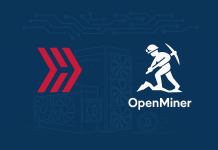[ad_1]
CryptoNight V8 Hardfork is Live Now! – How to Mine the New Monero
Today, Monero is conducting a planned hard fork to further secure the network from ASICs and to introduce some improvements to their existing system.
The CryptonightV8 hardfork comes hand by hand with the Monero 0.13.0 “Beryllium Bullet” software upgrade that brings three main changes:
- Bulletproofs – a modification to transaction size that also reduces fees by approximately 80% and verification time.
- CryptonightV8 (CryptonightV2) – The old CryptonightV7 PoW algorithm is replaced with a newer CryptonightV8 (also referred to as CryptonightV2). The new CryptonightV8:
- Bricks any existing (if any) Cryptonight7 ASICs
- Makes the production of any CryptonightV8 ASICs extremely expensive thanks to the increased memory bandwidth and the introduction of large and unavoidable computational latency to the main loop.
- Is 4 times more demanding for memory bandwidth. This means that older GPUs might experience a hashrate reduction of up to 20%.
- Newer GPUs and CPUs experience no significant hashrate reduction hit.
- Fixed Static Ring Size – This has to do with Monero privacy and untraceable transactions. Before the update, users could change the ring size to any value higher than 7. This 0.13.0 upgrade fixes the ring size to 11, making transactions more anonymous and secure.
- Minor Improvements and Bug Fixes – check the complete list here.
To Avoid any Confusions
Monero devs gave similar names to things that belong to different categories, which might be pretty confusing for some of you. Check the following definitions if you feel a bit confused on what all those terms mean. Otherwise, feel free to skip to the next section:
- CryptonightV8 – Cryptonight Version 8, can either mean the hard fork that took place October 18 or the new CryptonightV8 algorithm that was introduced with said fork.
- CryptonightV7 – Cryptonight Version 7, it was the first Cryptonight hard fork Monero devs have made half year ago to protect Monero from ASICs. CryptonightV7 is also the name of the algorithm that was introduced in the said fork.
- CryptonightV2 – Cryptonight Variant 2, algorithm. It is the second ASIC-resistant modification (variant) of the vanilla Cryptonight algorithm that was introduced in the CryptonightV8 fork. Also known as ‘CryptonightV8 algorithm’.
- CryptonightV1 – Cryptonight Variant 1, algorithm. It is the first ASIC-resistant modification (variant) of the vanilla Cryptonight algorithm that was implemented with the Cryptonight7 fork. Also known as ‘CryptonightV7 algorithm’.
- CryptonightV9 – Cryptonight Version 9, a hard fork that will follow the CryptonightV8. It will make Bulletproofs a must but it will not introduce a new algorithm. Therefore, after the CryptonightV9 fork happens, we will still be mining the CryptonightV8/CryptonightV2 algorithm.
TL:DR – CryptonightV8 might refer to either the latest hardfork or to the new algorithm that was introduced in said fork, whereas Cryptonight Variant2 (CryptonightV2) only refers to the new algorithm implemented in the CryptonightV8 hard fork.
CryptonightV9 Fork the Same Day as CryptonightV8??
The Cryptonight V9 fork will happen the same day as the V8 one with a several hour delay between the two. I am sure you are wondering right now “what the fork is going on?!” – I have asked myself the same thing 🙂 Let me explain why Monero needs two forks in a row.
As we already reviewed, CryptonightV8 introduces three major changes, the first one being Bulletproofs. V8 enables bulletproofs, meaning that all new Monero transactions will enjoy this new feature.
The issue is, there are still a lot of unconfirmed transactions that started right before the V8 fork. In V8, Bulletproofs are not mandatory, which means that those pre-V8 transactions can still be completed. After V9, Bulletproofs will be a must. To give the existing unconfirmed transactions not using Bulletproofs a chance to get confirmed, the V9 is delayed a bit.
Unlike the V8 update, V9 does not require us to take any actions. The software remains the same version (v0.13.0) So although there is technically two forks, only one software update is necessary.
Should We Take any Actions?
As a cryptocurrency holders and traders, we have to update our wallets. Those of us who mine XMR will also have to choose from new miners that support the CryptonightV8 algo.
Step 1: Update Your Wallet
- Backup your wallet and store the files somewhere safe.
- Use one of the following links to download and update to the newest version of your wallet:
Monero: Download from their Official Website
Step 2: Update Your Miner
Most of the popular miners people have been using to mine Monero already support CryptonightV8. If you haven’t, make sure you go to the page of your miner and update it. Here is a list of miners and the links to their download pages:
| Miner | Version | Supported Hardware | Download Links |
| Cast XMR | v1.6.0 | Radeon RX Vega & RX 470/480/570/580 GPUs | Download |
| SRBMiner | V1.7 – V8 (algo switching) | AMD | Download |
| XMRig | v2.8.1 | CPU | Download |
| XMR-AEON-STAK | 2.6.0 | AMD, NVIDIA & CPU | Download |
| XMRig AMD | v2.8.6 | AMD | Download |
| XMRig NVIDIA | v2.8.4 | NVIDIA | Download |
| XMR STAK | v2.6.0 Monero hardfork | AMD, NVIDIA & CPU | Download |
| CryptoDredge | v0.10.0 | NVIDIA | Download |
How to Mine Monero (CryptonightV8/CryptonightV2)
How to mine Monero CryptoNightV8 with Nvidia GPU
CryptoDredge
Monero Mining Hashrate with CryptoDredge miner for GTX 1080 Ti: download precompiled version here
- Hashrate: 950 H/s
- Clocks: +150/+750
- Power Limit: 100%
- Power Draw: 150w
XMRig Nvidia Miner
Monero Mining Hashrate with XMRig Nvidia miner for GTX 1080 Ti: download precompiled version here
- Hashrate: 885 H/s
- Clocks: +150/+750
- Power Limit: 100%
- Power Draw: 155w
XMR Stak Miner
Monero Mining Hashrate with XMR Stak miner for GTX 1080 Ti: download precompiled version here
- Hashrate: 750 – 780 H/s
- Clocks: +150/+750
- Power Limit: 100%
- Power Draw: 165w
XMR Aeon Stak
Monero Mining Hashrate with XMR Aeon Stak miner for GTX 1080 Ti: download precompiled version here
- Hashrate: 750 – 780 H/s
- Clocks: +150/+750
- Power Limit: 100%
- Power Draw: 165w
How to mine Monero CryptoNightV8 with AMD GPU
SRBMiner
Monero Mining Hashrate with SRBMiner miner for GTX 1080 Ti: download precompiled version here
- Hashrate: 950 H/s
- Clocks: 1250/2250
Cast XMR
Monero Mining Hashrate with Cast XMR miner for GTX 1080 Ti: download precompiled version here
- Hashrate: 885 H/s
- Clocks: 1411/2000
XMRig AMD
Monero Mining Hashrate with XMRig AMD miner for GTX 1080 Ti: download precompiled version here
- Hashrate: 830 H/s
- Clocks: 1250/2250
XMR Aeon Stak
Monero Mining Hashrate with XMR Aeon Stak miner for GTX 1080 Ti: download precompiled version here
- Hashrate: 685 H/s
- Clocks: 1250/2250
XMR Stak
Monero Mining Hashrate with XMR Stak miner for GTX 1080 Ti: download precompiled version here
- Hashrate: 690 H/s
- Clocks: 1250/2250
Why the Algorithm Change?
Monero developers firmly believe that ASICs lead to hashrate centralization and hence compromise the security and privacy of their coin. Their logic goes as follows: There are millions of people who own a decent GPU that can be used to mine Monero. While there are hundreds of GPU mining farms in the world too, those cannot compete with the hashrate produced by home miners from all around the globe.
ASICs are different. Fewer people buy those and there is a bigger chance that big mining farms can take the lion’s share of the global hashrate of a specific coin. Besides, Monero developers believe that it is easier for a government to regulate and control ASIC production than to control GPU production. Read the full story here.
According to independent research, it takes about 6 months for a company like Bitmain to design and launch a new ASIC model. ASICs are programmed to mine a certain algorithm on a hardware level. Therefore, by slightly changing the algorithm every 6 months, Monero developers can, in theory, keep the network ASIC-free.
In Conclusion
Personally, I am getting back to Monero mining after a few months break. Monero is one of the leading GPU-mineable coins now and I hope this new update will only make it stronger and more profitable to mine.
Do you think Monero is headed in the right direction? Let me know your opinion in the comments section below:
Thank you for reading. As always, your comments, suggestions and questions are welcome.
Subscribe and stay tuned for further updates!
(function(d, s, id) {
var js, fjs = d.getElementsByTagName(s)[0];
if (d.getElementById(id)) return;
js = d.createElement(s); js.id = id;
js.src = “http://connect.facebook.net/en_US/sdk.js#version=v2.11&xfbml=1”
fjs.parentNode.insertBefore(js, fjs);
}(document, ‘script’, ‘facebook-jssdk’));
[ad_2]
Source link




